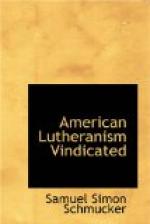“The real use of baptism,” (says he,) “is taught by these two particulars, the outward sign and the promise, ’he that believeth and is baptised shall be saved;’ also the words which are used in baptism, ’I baptise thee in the name of the Father, of the Son and of the Holy Ghost:’ that is, through this outward sign (baptism) I, in the place of God, testify that you are reconciled to God, and accepted of him, who is Father, Son and Holy Ghost. The Father receives you for the sake of the Son, and grants you the Holy Spirit, by which he will renew, make alive, comfort, and sanctify you.” [Note 4]
And, again, when discussing the subject, of pedobaptism, he thus describes his view:—“In and by baptism the Holy Spirit is given to children, who operates in them according to their measure (masse) or capacity, as he operated in John in the womb of Elizabeth. And although there, is a difference between the old and the young, inasmuch as the old are attentive to the works, still the influences of the Holy Spirit are in both old and young a tendency toward God.” [Note 5]
That this doctrine was also taught by the great majority of the most distinguished older theologians of our church, is a point which requires no proof to those acquainted with those authors. As their works are accessible to comparatively few of our readers, we will annex a quotation from several of them, at the same time abbreviating them as much as is consistent with perspicuity. Thus, Dr. Hunnius, professor at Wittenberg, and subsequently Superintendent at Luebeck, [Note 6] in his Epitome Credendorum, says:—“The sacrament of baptism is a spiritual action, instituted and ordained by Christ, by the performance of which a man is baptised with water, in the name of the Father, and the Son and the Holy Ghost; and by means of which he receives forgiveness of sins, is received into God’s covenant of mercy, and is made partaker of the merits of Christ, of adoption and of eternal salvation.” [Note 7] Again, “Baptism is not a sign of regeneration, that is to take place some time after baptism had been administered to him. For as baptism causes regeneration, it cannot be said to signify the same,” &c. [Note 8] And again, “Nevertheless, we have seen it to be the will of God, that they (children) should enter the kingdom of heaven, and it therefore becomes indispensably necessary for them to be regenerated. But this regeneration is brought about by no other means than by baptism, which we know to be the washing of regeneration and the renewing of the Holy Ghost,” &c. [Note 9] The celebrated Dr. Gerhard says, “The holy Trinity is present with his grace (in baptism). The Father receives the baptized person into favor; the Son bestows his righteousness upon him, and the Holy Spirit regenerates and renews him,—produces faith, regeneration and renovation, and seals the covenant of grace in the hearts of the baptized.” [Note 10]




